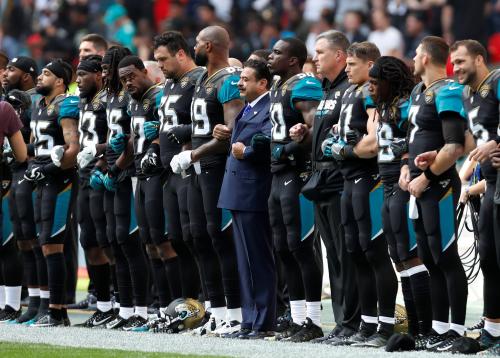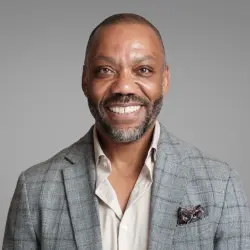The maps included within this post were updated on October 6, 2017 to correct coordinate errors for select urban areas.
This report launches a series of studies on majority-black cities in the U.S. Collectively, these analyses respond to the question, how are black cities doing? How does the concentration of black people impact municipal expenditures and investments? What are the strengths of black cities and how can we make them more resilient? Based on our findings, we will work with specific communities to draft strategies in order to form an agenda for black cities.
Black Lives Matter (BLM) is “a call to action and a response to the virulent anti-black racism that permeates our society,” according to its founders. Created after the killing of Trayvon Martin by George Zimmerman in 2012, the BLM banner organized protesters from across the country surrounding the extrajudicial killings of black people by police and others. The numerous spinoff organizations, political platforms, and demonstrations inspired by BLM is a testament of its standing as a full-fledged civil rights movement. BLM puts a renewed focus on the systemic repression of black people in policing, criminal justice, education, economic development, housing, electoral processes, and other quality of life indicators. Persistent racial disparities within these vital systems express the devaluation of black lives by public policy, and BLM makes clear that the right to exist is an a priori requisite for us to make necessary changes to federal, state, and local policies.
The right to exist extends to majority-black cities and towns
When Parliament Funkadelic sang “Hey, uh, we didn’t get our forty acres and a mule, But we did get you, CC, heh, yeah,” in the 1975 song “Chocolate City,” they relayed the social and political conditions of the then majority-black Washington, D.C., as well as the pride that comes from existing culturally within cities and towns. The aspiration for a “chocolate city” can be construed simply as wanting a numerical majority-black population, but it’s more of a claim for cultural relevancy and safety–black cities matter.
How we live is significantly shaped by where we live.
It’s been more expedient to subjugate black people by oppressing wherever they reside. Black people’s outcomes have been negatively influenced by past and present redlining, disproportionate exposure to pollution and hazardous waste, harmful zoning practices and post-disaster displacement. The manner in which de jure and de facto segregation concentrated people in specific locales makes it difficult to see where racial discrimination begins, and where place-based injustice begins. Housing discrimination and zip codes have been used to impose bad schools, policing, and healthcare. A few miles can cost black people more than 20 years of life expectancy. Place matters.
Racist policies strongly influenced the concentration of blacks in cities and towns, and we should strive to eliminate those inherent biases and structural inequities. But we should not assume that racism is the main ingredient in the social glue that bonds black folk. Black people won’t necessarily disperse or disappear with the eradication of racism. The social, human and cultural capital as well as other assets that have black people sticking together in the presence of racial injustice will continue to hold people in cities and towns in its absence. Black cities have certainly been shaped by racism, but black communities aren’t defined by it.
It’s hard to seek improvement for a city when its residents aren’t authentically respected. Black leadership, labor, intellectualism and culture that have been used to combat racism are assets worth preserving. But if those assets aren’t valued, “solutions” will inevitably end up making a city less black. Consequently, a community’s right to exist is an a priori condition for understanding how to improve a place. The demand for existence is what the discourse around equity and social justice for cities can learn from the black lives matter movement.
But the question of should black cities exist is one that’s being posed nationally. “Merger with the central city is an option more physically contiguous inner-ring suburbs should consider,” writes researcher Aaron Renn. While others like writer Brentin Mock make the case for saving the small black city. There are credible arguments and compelling evidence on either side of the debate. But let’s be clear: Gentrifying or merging our way to better city outcomes can be as preposterous as jailing significant portions of the black community in order to make it safer or wanting a disaster to “reset” a city.
“I find myself wishing for a storm in Chicago — an unpredictable, haughty, devastating swirl of fury,” wrote Chicago based opinion writer Kristen McQueary at the tenth Anniversary of Katrina. She added, “A dramatic levee break. Geysers bursting through manhole covers. A sleeping city, forced onto the rooftops. That’s what it took to hit the reset button in New Orleans. Chaos. Tragedy. Heartbreak.”
McQueary did not mention the decline of 100,000 black people, a third of which were low-income residents, from New Orleans after Hurricane Katrina ravaged the majority-black city. She also didn’t mention that black poverty at the anniversary was as bad as it was pre-Katrina. Clearly, McQueary cited New Orleans to speak to the need for change among the black residents of Chicago. However, she simply revealed why higher concentrations of black people are bigger targets for gentrification, divestment, merging and other manmade disasters.
If black lives matter, then black cities must matter too
In studying majority-black U.S. cities and towns, we aim to incorporate a broad understanding of what it means to be black in America and what it means to be a black city in America so we can look deeply at their intersections. We define “majority-black” locations to be those in which greater than 50 percent of the 2011 – 2015 American Community Survey (ACS) respondents answered that they are “Black or African-American; alone or in combination with one or more other races.”
To better understand cities at scale, we designate small, medium, and large cities and towns as having a total population below 2,500, between 2,500 and 50,000, and above 50,000 residents, respectively. These designations allow us to develop a focus on mid-size black cities.
There are more than 1,200 majority-black places in the U.S.; most (721) are rural towns that have populations smaller than 2,500 people, according to 2015 ACS Demographic and Housing Estimates. There are roughly 500 majority-black cities with populations between 2,500-50,000, and 42 chocolate cities with populations more than 50,000 people. These cities and towns are displayed on the following map (there are no majority-black cities or towns outside the continental US).

Click for a more detailed breakdown of small, medium, and large black cities (PNG files).
Recognizing a person or place begins with naming, and our series on black cities begins with naming each one. For the full list of black cities as well as their population counts, click here (Excel).
Among the majority-black cities, most black people live in large ones. However, almost half of chocolate city residents are in medium-sized cities. Almost nine million black people experience being the majority in their towns.
Michael Brown, the 18-year-old unarmed teenager killed by a police officer in Ferguson, Mo. on August 9, 2014, represented and symbolized what many residents experience in the medium-sized cities in the absence of the national spotlight. The numerous criminal justice violations in Ferguson, which led to the U.S. Justice Department filing a civil lawsuit against the City of Ferguson, sadly surfaced primarily as a result of Brown’s death. Problems in education, healthcare, transportation, and economic development are often obscured by larger cities often close by (i.e. St. Louis). Small and medium cities lack the attention and support, but often carry the same if not greater burdens of their larger counterparts. Consequently, the series will pay particular attention to cities like Ferguson.

Ultimately, our series of analyses will test the hypothesis that black cities are treated like black lives in America. We will look to see if biased policies that impact black individuals extend to majority-black cities. The examination uncovers whether public fiscal commitments are the same in majority-black cities as those in majority white cities. We’ll document the racial composition of the cities’ official leaders and analyze potential impacts. In addition, the series will compare indicators such as income, education, democratic participation, and other indicators of other racial groups in black cities.
Footnote
1 United States Census Bureau / American FactFinder. “DP05: ACS Demographic and Housing Estimates.” 2011 – 2015 American Community Survey. U.S. Census Bureau’s American Community Survey Office, 2011. Web. 21 September 2017. <http://factfinder2.census.gov>.
Photo credit: Nicolas Nova/Flickr.






Commentary
Recognizing majority-black cities, when their existence is being questioned
Thursday, October 5, 2017